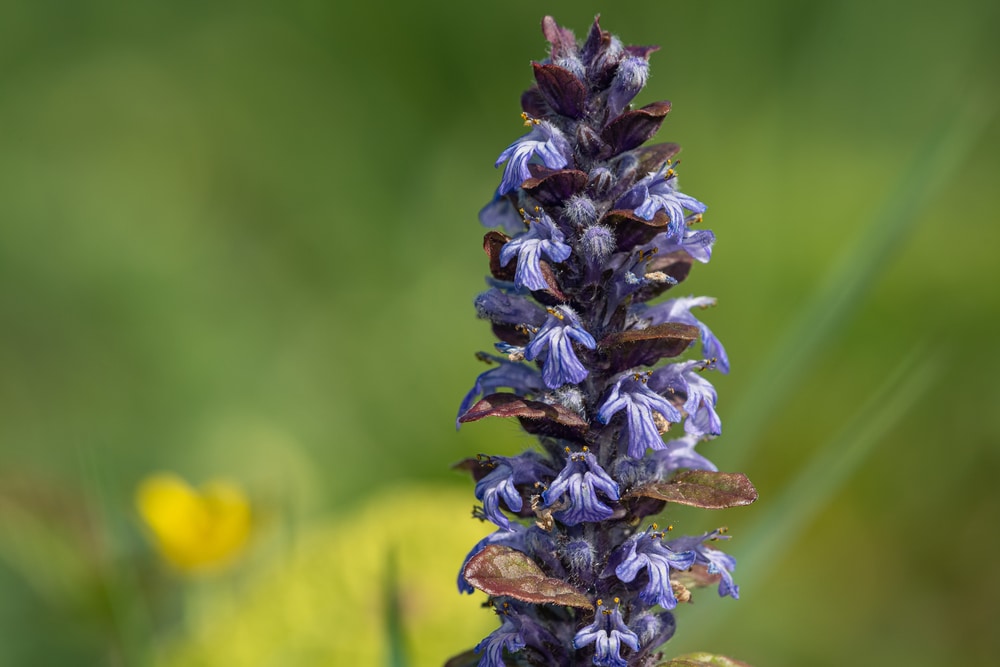Last Updated on
It’s common to find a bugle plant in your garden, but what are this blue flower’s characteristics? Where can you expect to find it? And how can you care for it? We’re sharing all of our knowledge in today’s guide.
Overview
- Scientific Name: Ajuga reptans
- Common Name/s: common bugle, blue bugle, bugleherb, bugleweed, carpetweed, carpet bugleweed
- Family: Lamiaceae
- Origin: native
- Habitat: damp deciduous woods, woodland rides, unimproved grassland, shaded places
- Flowering Season: May to July
How to Identify This Plant
This type of plant has large, oval leaves that spread out at its base and smaller leaves that grow up to its flower spikes. In between the leaves are small, purple/blue flowers with protruding sprouts shaped like skirts, and often, the variegated leaves have faint stripes running down them. They can get up to 20cm in height.
Where to Find Them
/image
Also referred to as Ajuga reptans, these flowers are typically found in woodland clearings and damp grassland. This plant has blue flowers that are recognizable and spread using runners.
Moreover, they’re typically grown in shady locations but grow at their best in full sun. Although this offers slower growth, it’s typically easier to control. The plant prefers moist soil, but it’s incredibly adaptable and can even withstand some drought.
Once the bugle plant has become established, it requires little care; unless it’s dry, the ajuga plant can sustain itself with normal rainfall, and there’s no need to fertilize it. However, if the plant is growing in direct sunlight, you’ll need to water it more often.
Bugle (Ajuga reptans) Common in woodlands and damp grassland throughout the UK. The flowers are loved by bees. This plant was thought by medieval herbalists to be a cure-all but particularly good at stopping bleeding. #Exmoor #StayHome @ExmoorNP @SomersetWT @wildflower_hour pic.twitter.com/fLNAWYFeGX
— Exmoor NPCs (@ExmoorNPCs) April 29, 2020
Seasons
Ajuga reptans doesn’t like waterlogged conditions. Plant them out in the spring in a north-facing area in a sheltered position. These plants are invasive, so it’s important to cut them back as required.
Is Bugleweed Invasive?
Bugleweed has become one of the common planting species that’s invasive. Thankfully, there are ways to get this plant under control if you don’t want it in your garden. To stop this plant from spreading, try hand pulling, one of the best solutions for an environmentally-friendly approach. Water the area the day before you intend to pull the bugle, plus loosen the soil around the plants with a garden fork.

Take your time to remain careful and not damage any surrounding plants; dig deep under the roots. Take care not to snap the roots, as this could lead to increased spreading. You’ll have to remain persistent and patient, but this technique will help to prevent the bugle plant from becoming increasingly invasive.
Is Bugleweed Poisonous?
It’s reported that ajuga varieties are safe around most people. They’re also not poisonous to dogs.
What Is Bugleweed Used For?
You can use Ajuga reptans to treat premenstrual syndrome, breast pain, anxiety, and insomnia, and can even help with nosebleeds and heavy bleeding during a menstrual cycle. You may also find it in oils and ointments for skin treatments.
But you should consider that it can lower blood sugar levels if consumed in high amounts, so make sure to check with a doctor if you have any major concerns.
Is Bugle Edible?
Yes. Steep the leaves in tea or add to salads or casseroles. The young shoots work particularly well in salads. If you’re planning on consuming this flower, you may need them to grow a little longer than usual. And if you leave the flowers uncut between May and July (or late spring), they’ll become very attractive to bees.
Growing These Attractive Flowers
Ajuga requires care, time, and strategy when and where you plant it. But, if planted wisely, this blue/purple ground cover plant can provide a dense ground cover to keep weeds away. One of the best and easiest ways to grow this flower is by checking what will surround it in the garden bed.
Use moist soil. In hot, humid areas, this deep blue garden flower needs to have plenty of air circulation to prevent any nasty fungal diseases, such as crown rot. You’ll want to plant it in the spring, with around a foot of space in between it and other plants in your garden. Furthermore, your planting holes should be 8–15 inches apart to ensure successful transplanting, and you’ll need to loosen its roots before you place it into the ground.
Ordinarily, you’ll only need to water it three-four weeks after it’s been planted but make sure it doesn’t dry out in the sun.
Do you have any insight into this purple perennial flower? Share your facts and thoughts on Ajuga reptans in the comments to share with others.
Amy is a U.K.-based writer and editor with a penchant for helping consumers find the best home products for their needs, as well as providing easily digestible guides for living better at home. Her dedication to her work means she can usually be found elbow-deep in research or hunting down samples of the latest and greatest on behalf of her readers.
An avid DIYer herself, Amy’s passion lies in teaching others how they too can achieve their dream homes by tackling some of those pesky projects themselves! Whether it’s building furniture from scratch or turning an old dresser into a coffee table, Amy is always happy to share what she knows about making your house feel like home without spending a fortune.



